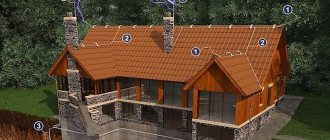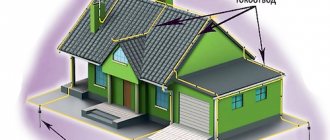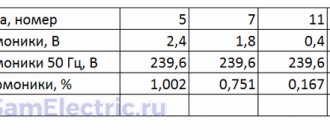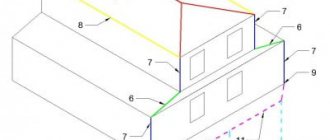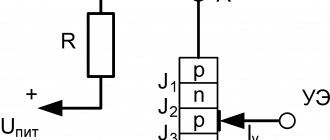The procedure for installing lightning drains (lightning protection) at industrial and civil facilities is regulated by a number of regulations and standards, starting with the PUE and ending with individual departmental instructions. All these documents contain requirements for lightning protection in terms of design (calculation), installation, commissioning and maintenance of these systems.
Parts of the structure
For a more precise understanding of the essence of the requirements, it should be taken into account that a typical lightning protection design consists of the following main parts:
lightning rod mounted at the highest point of the object;- a special tape conductor used as a connector of the discharge receiver with a grounding device (GD);
- the ground electrode itself, which ensures the discharge current flows into the ground.
Thus, each of the constituent elements of lightning protection performs its own, well-defined function that meets the requirements of current regulations, in particular PUE.
Types of material (profiles)
According to the requirements of the PUE, which contain instructions on what the resistance of current flow in the ground should be, in most cases this indicator is set at a level of no more than 4 ohms. To obtain this value, you usually have to make a lot of effort to adhere to the same technology requirements.
First of all, this concerns the materials used in assembling the grounding loop, selected based on the following conditions:
- When choosing pins, preference should be given to ferrous metal blanks;
- The most commonly used rod is a standard size of 16-20 mm or a corner with parameters 50x50x5 mm and a metal thickness of about 5 mm;
- It is not allowed to use reinforcement as circuit elements, since it has a hardened surface that affects the normal flow of current;
- For these purposes, it is pure rod that is suitable, and not its reinforcement substitute.
Note! For areas with dry summers, thick-walled metal pipes are best suited, the lower end of which is flattened into a cone, and then several holes are drilled in this part of the pipe. According to the provisions of the PUE, before placing them in the ground, holes of the required length are first drilled, since driving them manually is quite problematic
In the case of a particularly dry summer and a sharp deterioration in the parameters of the ground electrode, a concentrated saline solution is poured into the hollow parts of the pipes, which makes it possible to obtain the resistance that should be in accordance with the requirements of the PUE. The length of pipe blanks is selected within 2.5-3 meters, which is quite enough for most Russian regions
According to the provisions of the PUE, before placing them in the ground, holes of the required length are first drilled, since driving them in manually is quite problematic. In the case of a particularly dry summer and a sharp deterioration in the parameters of the ground electrode, a concentrated saline solution is poured into the hollow parts of the pipes, which makes it possible to obtain the resistance that should be in accordance with the requirements of the PUE. The length of pipe blanks is selected within 2.5-3 meters, which is quite enough for most Russian regions.
This type of profile blanks has special requirements regarding the order of their placement in the soil and consists of the following:
- Firstly, the pipe elements of the protective circuit must be placed at a depth exceeding the soil freezing level by at least 80-100 cm;
- Secondly, in particularly dry areas, approximately a third of the length of the ground electrode should reach wet soil layers;
- Thirdly, when fulfilling the second condition, one should focus on the peculiarities of the location of the so-called “groundwater” in a given region. If they are located at a significant depth, according to the rule formulated in the provisions of the PUE, it will be necessary to prepare longer pipe sections.
The type and profile of the pin blanks used in the construction of the grounding switch can be found in the figure below.
In practice, in most regions of Russia, a steel corner and a strip of the same metal are usually used. In order to obtain more accurate parameters of the grounding elements used, geological survey data will be required. If this information is available, it will be possible to involve specialists in calculating the parameters of the ground electrode.
What is metal bonding made of?
The elements connecting the pins (metal bond) are usually made of the following electrical materials:
- A typical copper busbar with a cross-section of less than 10 mm2;
- Aluminum strip with a cross section of about 16 mm2;
- Steel strip 100 mm2 (standard size – 25x5 mm).
Classic metal ties are usually made in the form of steel strips cut to size and welded to the corners or heads of the rod.
Important! The quality of the welding joint determines whether this grounding device or circuit can pass verification tests for compliance of the contact resistance with the standardized value (4 Ohms)
When using more expensive aluminum (copper) strips, a bolt of a suitable size is attached to them for welding, on which the supply busbars are subsequently fixed
The main thing you need to pay attention to when arranging any connections is the reliability of the resulting contact
To do this, before preparing the bolted joint, it is necessary to thoroughly clean both parts to be connected until the shine of clean metal appears. Additionally, it is advisable to sand these places, and after tightening the bolt, tighten it well, which will ensure more reliable contact.
Normative base
The list of standards and regulatory documents that define the key points for the arrangement of lightning protection includes:
PUE (edition No. 7) “Lightning protection of buildings and structures”;- instruction RD 34.21.122-87 (Gosenergonadzor);
- instruction of the Ministry of Energy under number SO 153-34.21.122-2003;
- SNiP 3.05.06-85;
- a number of GOSTs and standards concerning the procedure for arranging lightning rods and grounding.
Paragraphs 4.2.133-4.2.142 of the PUE define the general principles of organizing lightning protection of electrical installations and the resulting overvoltages.
The requirements of these paragraphs apply to switchgear (switchgear) and transformer substations (transformer substations) of open and closed type, operating in power supply circuits, as well as other distribution and station electrical equipment.
Instruction RD 34.21.122-87 applies to the procedure for organizing lightning protection at designed civil and industrial facilities, taking into account their main functional purpose.
In addition, it classifies each of these buildings into a specific category, assigned depending on the danger of a lightning strike.
Another instruction (under the name SO 153-34.21.122-2003) concerns all types of buildings and structures, including industrial communication systems. It determines the procedure for taking into account lightning protection documentation during project development, construction, operation and reconstruction of all specified facilities.
And finally, the requirements of GOST (including the standards and rules in force in construction) apply to the procedure for arranging individual elements of lightning protection systems. Let's look at each of the documents listed above in more detail.
Test and inspection
- Welding joints for strength. This is done visually or by tapping with a hammer.
- Bolted connections and ties. It is necessary to tighten all connections, especially those that will be in the ground or on the roof.
- Ground resistance. It is measured with a special device - an insulation resistance meter.
- The transition resistance of contacts and joints is measured with an insulation resistance meter or an ohmmeter.
- Measuring current flow resistance with an insulation resistance meter.
- Check for compliance with project documentation.
- Reliability of fastening the lightning rod and intermediate clamps.
It is recommended that before the spring-summer period, an annual visual check of the system for damage and breaks after winter icing and winds is carried out.
It is not worth saving money on protecting people from electric shock and the safety of housing and electrical appliances. The best option is a set of measures to prevent the consequences and destruction from lightning strikes.
PUE (seventh edition)
Separate paragraphs of the PUE stipulate that switchgear and 20-750 kV open-type transformer substations must be equipped with lightning rods. For some types of structures, the absence of special lightning protection is allowed, but only under the condition of a limited duration of thunderstorms throughout the year (no more than 20 hours).
The same closed structures require lightning protection only in areas with a thunderstorm duration index of more than 20.
Grounding
In the case where closed buildings have a metal roof, lightning protection is carried out using grounding devices connected directly to the roofing. If the roofing is made of reinforced concrete slabs, then if there is good contact between the individual elements of the building, grounding through the reinforcement included in them is allowed.
Protection of closed switchgear and transformer substations buildings is carried out either using rod-type lightning rods or by laying a special metal mesh.
The use of these protective structures is considered justified only in cases where lightning protection is installed on the reinforced concrete roof of buildings, the slabs of which do not have an electrical connection with the ground.
Rod and mesh protection
When installing standard lightning rods on a protected structure, at least 2 down conductors are laid from each of them towards the grounding conductor, located on different sides of the building.
A specially designed lightning protection mesh, laid on top of the roof on special holders, is made of steel wire with a diameter of 6-8 millimeters.
For hidden installation, according to the PUE, such a lightning rod is placed under the roofing (on a layer of insulating or waterproofing material with non-flammable properties).
The protective structure, made in the form of a mesh, should consist of cells with an area of no more than 12x12 meters, and its nodes are recommended to be fixed by welding.
Down conductors or descents used to connect the lightning protection mesh to the charger must be installed along the perimeter of the building every 25 meters (at least).
The ground electrode included in the lightning protection must ensure unimpeded flow of the discharge current into the soil, which is achieved due to its low contact resistance and good contact with the ground.
First category
The highest level of lightning protection is the first. It is applicable for buildings with hazardous areas. Lightning protection of such buildings is carried out using cable or rod lightning rods, which stand separately from each other. Please note that at the same time it is necessary to select the correct grounding conductor. For this purpose, the following options are used:
- One footrest made of reinforced concrete, the length of which is at least 1.8 meters. And along with it there is one reinforced concrete pile, the length of which should reach about 6 meters.
- One support with a diameter of at least 0.5 m, made of reinforced concrete. In this case, it should be buried into the ground at least 6 meters.
- The foundation is made of reinforced concrete, the surface area of contact with the ground is quite extensive. In this case, the foundation can be of different shapes.
- An artificial ground electrode, which will consist of several combined electrodes.
Instruction RD 34.21.122-87
In accordance with the provisions of this document, when designing buildings and structures for economic and domestic purposes, the requirements for equipping them with special lightning protection must be observed. The standards defined by this instruction do not apply to power lines, switchgear and transformer substations, as well as contact networks and communication equipment.
This document establishes the procedure for arranging lightning protection systems at constructed facilities, taking into account their placement outside and inside buildings.
In addition, it defines a list of protective measures taken in the event of reconstruction of a building or installation of additional electrical equipment in its open spaces (on the roof, in particular).
In addition to the requirements of this instruction, when designing structures for one purpose or another, the current provisions and rules established by state standards and construction regulations must be taken into account.
According to the rules prescribed in RD 34.21.122-87, all objects subject to lightning protection, in accordance with the features of their design and geographical location, are divided into 3 categories. The table, which brings together the various types of objects to be protected, their location, as well as the category assigned to them depending on this, can be found in the Appendix.
| Item No. | Buildings and constructions | Location | Type of protection zone when using rod and cable lightning rods | Lightning protection category |
| 1 | Buildings and structures or parts thereof, the premises of which, according to the PUE, belong to zones of classes B-I and B-II | Throughout the USSR | A | I |
| 2 | The same classes B-Ia, B-Ib, B-IIa | In areas with an average duration of thunderstorms of 10 hours per year or more | With the expected number of lightning strikes per year of a building or structure N<1 - A; N≤1 - B | II |
| 3 | Outdoor installations that create, according to the PUE, a class B-Ig zone | Throughout the USSR | B | II |
| 4 | Buildings and structures or parts thereof, the premises of which, according to the PUE, belong to zones of classes P-I, P-II, P-IIa | In areas with an average duration of thunderstorms of 20 hours per year or more | For buildings and structures of I and II degrees of fire resistance at 0.12 - A | III |
| 5 | Small buildings located in rural areas of III - V degrees of fire resistance, the premises of which, according to the PUE, belong to zones of classes P-I, P-II, P-IIa | In areas with an average duration of thunderstorms of 20 hours per year or more at N<0.2 | — | III (clause 2.30) |
| 6 | Outdoor installations and open warehouses, creating, according to the PUE, a zone of classes P-III | In areas with an average duration of thunderstorms of 20 hours per year or more | At 0.12 - A | III |
| 7 | Buildings and structures of III, IIIa, IIIb, IV, V degrees of fire resistance, in which there are no premises classified according to the PUE as explosion and fire hazardous class zones | Same | At 0.12 - A | |
| 8 | Buildings and structures made of light metal structures with combustible insulation (IVa degree of fire resistance), in which there are no premises classified according to the PUE as explosion and fire hazardous class zones | In areas with an average duration of thunderstorms of 10 hours per year or more | At 0.022 - A | III |
| 9 | Small buildings of III-V degrees of fire resistance, located in rural areas, in which there are no premises classified according to the PUE as zones of explosion and fire hazardous classes | In areas with an average duration of thunderstorms of 20 hours per year or more for III, IIIa, IIIb, IV, V degrees of fire resistance with N<0.1, for IVa degree of fire resistance with N<0.02 | — | III (clause 2.30) |
| 10 | Computer center buildings, including those located in urban areas | In areas with an average duration of thunderstorms of 20 hours per year or more | B | II |
| 11 | Livestock and poultry buildings and structures of III-V degrees of fire resistance: for cattle and pigs for 100 heads or more, for sheep for 500 heads or more, for poultry for 1000 heads or more, for horses for 40 heads or more | In areas with an average duration of thunderstorms of 40 hours per year or more | B | III |
| 12 | Smoke and other pipes of enterprises and boiler houses, towers and derricks for all purposes with a height of 15 m or more | In areas with an average duration of thunderstorms of 10 hours per year or more | B | III (clause 2.31) |
| 13 | Residential and public buildings, the height of which is more than 25 m higher than the average height of surrounding buildings within a radius of 400 m, as well as free-standing buildings with a height of more than 30 m, distant from other buildings by more than 400 m | In areas with an average duration of thunderstorms of 20 hours per year or more | B | III |
| 14 | Detached residential and public buildings in rural areas with a height of more than 30 m | Same | B | III |
| 15 | Public buildings of III-V degrees of fire resistance for the following purposes: pre-school institutions, schools and boarding schools, hospital hospitals, dormitories and canteens of healthcare and recreation institutions, cultural, educational and entertainment institutions, administrative buildings, train stations, hotels, motels and campsites | Same | B | III |
| 16 | Open entertainment institutions (auditoriums of open cinemas, stands of open stadiums, etc.) | Same | B | III |
| 17 | Buildings and structures that are monuments of history, architecture and culture (sculptures, obelisks, etc.) | Same | B | III |
Why should you turn to professionals?
Installation of such a system requires a careful and responsible approach. Any inaccuracies or errors can lead to disastrous consequences. Lightning protection of categories 1, 2, 3, performed by qualified specialists, is a guarantee:
- long and uninterrupted operation;
- maximum level of security;
- reliability;
- affordable cost;
- completing the task in a short time;
- professional determination of the level of lightning protection;
- prompt and competent installation of the system.
Finding an alternative solution and maximum quality are the main advantages of turning to specialists.
Requirements SO 153-34.21.122-2003
In addition to issues related to the arrangement of lightning protection at government facilities of any form of ownership, the instructions under this designation discuss the procedure for preparing and storing all accompanying documents.
Documentation
The as-built documentation prepared in this case must include a complete set of calculations, diagrams, drawings and explanatory notes that determine the procedure for installing special equipment within the protected area.
When preparing it, both the location of the building on the general development plan (taking into account the laid communications) and the climatic conditions in the area should be taken into account.
Delivery of the object
In addition, this document establishes the general procedure for the technical acceptance of lightning protection systems, as well as the specifics of their commissioning. It is specifically stipulated that for the acceptance of a building or structure, a special commission is appointed, consisting of representatives of the contractor and the customer, as well as a fire service inspector.
The working commission must be provided with all documents on the lightning protection being installed, including a test report for down conductors and grounding conductors. Members of the commission must familiarize themselves with the results of a visual inspection of all components of lightning protection, as well as with the measures taken to protect the facility from the removal of dangerous potentials and overvoltages.
Based on the results of studying the documentation provided by the developer, acts of acceptance and admission of lightning protection equipment into operation are issued.
After this, special working passports must be issued for each individual device (for the entire system and the ground electrode), which remain with the person responsible for the electrical facilities of the facility.
Examination
In the sections of the instructions relating to the operation of the lightning protection devices put into operation, it is separately stipulated that the procedure for their maintenance and maintenance is determined by the basic provisions of the PUE. At the same time, in order to maintain the systems in working order, annual inspections of all its components must be carried out.
Such surveys are organized before the start of the thunderstorm season, as well as after any changes or improvements are made to the lightning protection design.
Initial data for design
To begin, the designer needs to collect the following information and obtain the necessary drawings from the customer:
- general plan of the facility (all structures that need to be protected, as well as infrastructure, technological lines, ground and underground communications, pipelines, telecommunication channels, electrical and low current, etc.) (if it is necessary to protect several buildings or take into account the proximity of others)
- separate drawings (plans) of the roof and facades of the building with a list of materials used in construction, including the presence and materials of the drainage system
- other drawings necessary for the calculation as part of the construction and architectural parts, the presence and overall dimensions of roof superstructures
- the purpose of the object, the degree of presence of people in it
- climatic conditions of the area, zone of thunderstorm activity
- soil characteristics (soil type, groundwater level)
Technical standards
The list of working documents regulating purely technical issues of lightning protection includes various standards, regulations and amendments, drawn up in the form of a set of special recommendations.
A number of standards included in the regulatory framework and listed in the second section of the article can be taken as a sample of such amendments and special comments.
The last remark concerns building codes and regulations, as well as a number of GOSTs and standards related to the development and operation of modern lightning protection equipment.
In conclusion, it should be noted that all the documents reviewed naturally complement each other, covering a complete list of issues related to the arrangement and maintenance of protection systems against natural electricity discharge.
Rules for grounding pipelines
Grounding of pipelines is a mandatory measure, enshrined in the PUE. This is how you can increase the safety of their operation, because static electricity accumulates in pipe systems, plus there is always the possibility of lightning striking the pipes. The requirements of the rules for the construction of electrical installations are to provide grounding not only for external pipelines, but also for internal ones (technological and communication).
The PUE clearly regulates how pipelines should be grounded.
- Firstly, the pipe system must be a single continuous network connected into a single circuit.
- Secondly, pipelines must be connected to the grounding system at at least two points.
As for the first position, this does not mean that the pipeline system itself must be continuous. Here it will be enough to ensure the connection of sections or individual pipelines into one single network, for which so-called wafer jumpers are most often used. In fact, this is an ordinary copper wire of the brand either PVZ or PuGV. Fastening of jumpers to the pipeline is ensured by welding, bolting, or a grounding clamp for pipes is installed.
As for the second position, experts recommend not to scatter along the entire line of the technological chain, just to make a connection at the beginning and end of the circuit.
Operation of the lightning protection system.
After installing the lightning protection system, the installation organization checks the operability of the system, connecting all elements and grounding conductors. After putting lightning protection into operation, it is necessary to inspect this system once a year, before the start of a thunderstorm period. Checking of grounding conductors is also provided.
Installation in a private house or country house is the responsibility of the owner. His safety and property. Fires from lightning strikes do not occur as often as from other causes. But if lightning strikes a building or structure, then you cannot escape from its damaging factors if you do not have lightning protection.
If you are concerned about your health and property, then our advice is to contact competent specialists to calculate the probability of a lightning strike on a building, and based on the calculation result, select and install a lightning protection device.
Tags: sconce, type, harm, choice, house, , grounding, cable, how, category, design, circuit, , magnet, lightning protection, installation, potential, rule, principle, check, wire, project, start-up, , size, calculation, reversal, row, network, connection, resistance, means, term, ten, type, current, shield, electricity, effect
Features of protecting urban facilities
The lightning protection system for any city structures (including residential apartment buildings) can have a variety of designs. The choice of one or another protective design option is usually determined by the following factors:
- design features of the protected structure itself;
- the presence of electrical equipment located in open and closed spaces of the building, as well as its vulnerability from the point of view of lightning strikes;
- quality of grounding used in the protection system;
- an indicator of thunderstorm activity characteristic of a given area.
In addition, the requirements for lightning protection of such buildings must satisfy current standards, which involve dividing them into different categories from the point of view of protection.
These categories take into account the presence in these buildings and the nature of the storage or processing of explosive and flammable substances. At the same time, category 1 is considered the most dangerous in terms of lightning damage, and category 3 is considered the safest.
An important factor that has a significant impact on the choice of lightning protection for an urban facility is its “surroundings,” which may include high-rise objects (boiler room pipes, local television towers, etc.).
Taking into account all the above factors, lightning protection is organized for typical urban facilities, including apartment buildings and industrial enterprises.
Lightning rod device
Any lightning rod consists of three main elements: a lightning receiver, conductor conductors (usually made of copper or steel) and a clamping circuit that transmits the accumulated charge into the ground to a depth of one and a half to three meters. The simplest type of such a device is a metal mast. The support posts of lightning protection devices are usually made in the form of steel pipes of the same diameter, as well as columns made of wood or reinforced concrete. Current-carrying parts of lightning removal devices are often attached to the structural elements of the structures themselves. Lightning traps on rod-type lightning rods are made of steel and must be at least 20 centimeters high.
Lightning rod (lightning rod) - device number 1 for protecting buildings from lightning
Cable lightning rods are also called linear; they are a wire stretched between a pair of iron masts. Such a device allows you to collect all lightning strikes entering the protection field. Linear lightning rods are connected to the ground loop with a large-diameter copper cable or simple metal fittings.
Linear lightning rod diagram
On high-rise buildings, a metal or reinforced concrete frame is often installed as a down conductor.
Note! It is imperative to establish a reliable connection (provided by the snip) for all frame elements. Balcony railings, emergency evacuation stairs and other metal structural elements can also serve as down conductors.
Conductor conductors are attached to the wall surfaces of structures using plastic clips; you can also use a cable channel, which will help increase the service life of the lightning conductor. When planning construction, it is necessary to provide for the presence of grounding loops with a pitch of 20-30 meters along the entire perimeter of the building.
Operating principles of lightning rods
The operation of these devices is based on the fact that lightning always strikes the highest and most prominent metal parts. All lightning rods have their own protection zone - this is an area that is protected from direct lightning strikes. When a discharge approaches, the very first lightning strikes the highest point of a building or structure, and the protection discharges electrical energy into the soil, and the protected object itself is not affected. In the case when the dimensions of the structure exceed the dimensions of the security zone of one lightning rod, additional devices of this type are installed (three or four interconnected rod devices with a common grounding).
The reliability of the protective zones provided by lightning rods, according to GOST, is divided into types: “A” – the degree of reliability is close to one hundred percent (99.5) and “B” – the degree of protection is from 95 percent. The protective zone itself is cone-shaped; its height and base area are determined by the dimensions of the building. The highest height of lightning rods allowed by building codes is 150 meters.
Lightning protection system design
The lightning protection system is installed on a fully constructed building, in the building structures section. For the correct installation of lightning protection, a project is developed by a licensing organization. The project calculates the number of lightning protection devices and the correctness of their installation. Next, based on the design, lightning protection is installed and subsequent tests are carried out with acceptance into operation.
The components of the lightning protection system are:
Lightning rod. The task of which is to intercept the electrical discharge of lightning at the top point of the building. There are 3 types of lightning rod design: mesh, rod, cable structure. Next, the electric charge from the lightning is transferred to the down conductor.
Down conductor. The task of which is to connect the lightning rod and the ground electrode to transmit to the latter a discharge of electricity from a lightning strike. The current conductor is a metal conductor with low resistance and low heating temperature when an electric current passes. The minimum diameter of a round down conductor is 6 mm or more. To connect the down conductor, welding seams and bolted connections are usually used. The number of connections on the down conductor should be minimal. Down conductors may be laid in the middle of the building and outside. The down conductor elements are laid along the shortest path to the ground electrode.
Ground electrode. The task of which is to transmit electric current from the down conductor to the ground. It is carried out in the form of one or several conductors lowered into the ground to the calculated depth. Protected from corrosion by special materials. It is allowed to connect the building's household grounding and lightning protection grounding.
Arrangement of lightning protection for an apartment building
External or openly located lightning protection of a residential building is organized taking into account the factors listed above and is equipped according to generally accepted standards (in the absence of a high-rise building with a lightning rod nearby).
Thus, for a typical urban structure, the roof of which is made in the form of ceilings covered with roofing felt, a pin fixed on the extension to the elevator exit (next to the antenna) can be used as a lightning rod.
After it is secured, a thick steel wire with a cross-section of at least 6-8 millimeters is welded to the pin outlet. The wire goes down along the wall and its other end is connected to the ready-made ground electrode using the same welding.
When lowering the lightning protection down conductor, you should ensure that the wire is securely fastened to the walls of the building using specially designed clamps.
When installing lightning protection for an apartment building, one should not lose sight of its internal component, represented by special equipment (surge protection devices, in particular).
This device provides protection for communication equipment installed within the boundaries of the house from surge voltages that occur during a thunderstorm.
In addition, with its help it is possible to prevent undesirable consequences from secondary effects of lightning (noise) that threaten the internal electrical networks of the house and household appliances connected to them.
